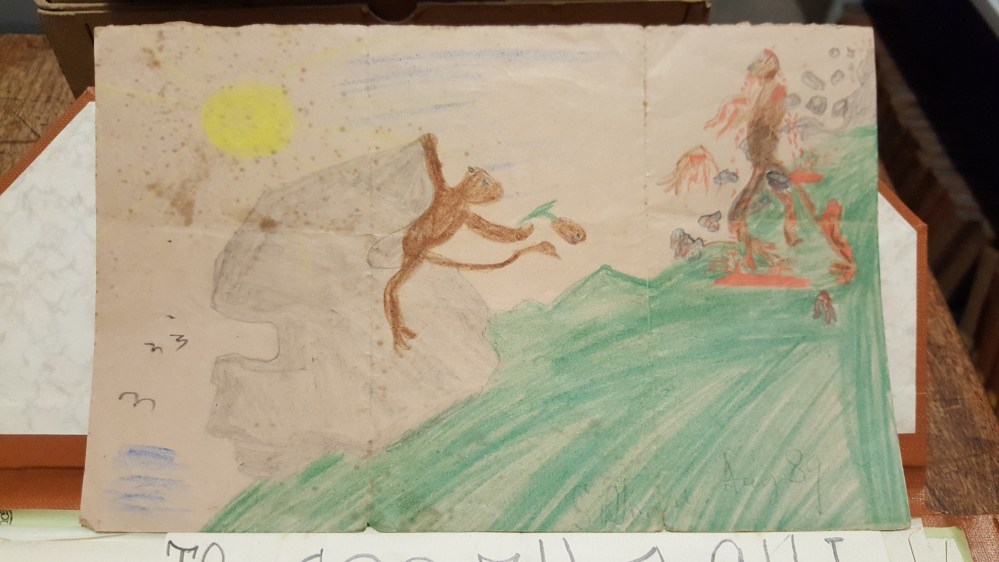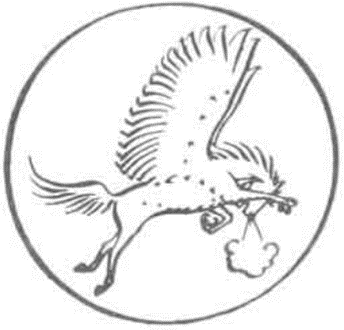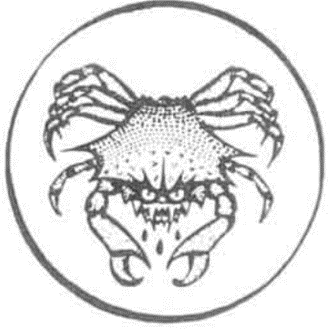Before The Lord of the Rings, before The Chronicles of Narnia and before Game of Thrones came The Worm Ouroboros by E.R. Eddison – the pioneering Leeds-born fantasy author of the early 20th-century. This week on the Secret Library blog we hear from Library Officer Philip Wilde, who talks us through Eddison, his life in Leeds and the continuing influence of his invented worlds…

In a corner of the Parish Church of St John the Baptist in Adel near Leeds there is a patch of ground occupied by members of the Eddison family. Amongst these is to be found the grave of Octavious Eddison where is also interred the remains of his wife, Helen Louisa and ‘their elder son, Eric Rücker. Born November 24. 1882. Died August 18. 1945’.

In August 1889 when the not quite seven year old Eric Rücker Eddison drew the fantastical picture shown above little did he or his parents, solicitor Octavius and Helen Louisa (née Rücker), know that one day he would go on to write a series of Science fantasy novels that would prompt J. R. R. Tolkien to refer to him as ‘…the greatest and most convincing writer of invented worlds that I have ever read.’ [i]
E. R. Eddison, as he was later to become known, was born in Adel, Leeds and had his early education at home with a succession of private tutors. These he shared with a boy who was to become a lifelong friend, the future author of Swallows and Amazons, Arthur Ransome. In his autobiography Ransome was later to say, ‘I think any unprejudiced observer would have said that Ric and I were a pair of horrid little boys, and that it was high time we were sent to school’. [ii] Eddison continued his education at Sunningdale Preparatory School in Berkshire after which he attended Eton followed by Trinity College, Oxford in 1901. It was in these latter institutions where he read classics that he was able to actively pursue his interest in the Icelandic sagas and science fiction.
His time at Oxford was followed by a twenty two year career in the civil service where he was to rise to the post of Deputy Comptroller-General of the Department of Overseas Trade. However, he would often retreat to the fantastical worlds he was creating that were the domains of the Great Lords, Juss, Goldry Bluszco, Spitfire, Brandoch Daha and to the lands of Zimiamvia where no mortal may tread.
In 1922 he published his first and most notable fantasy work, The Worm Ouroboros. The Worm, a serpent or snake, derived from the old Norse, ormr. This he followed with three volumes set in the imaginary world first observed by the Lords Juss and Brandoch Daha as they gaze from the top of great mountain, Koshstra Pevrarcha in The Worm, Zimiamvia, known as The Zimiamvian trilogy: Mistress of Mistresses (1935), A Fish Dinner in Memison (1941), and The Mezentian Gate (published posthumously in 1958). His Icelandic sagas were: Styrbiorn the Strong (1926) and his much admired translation of Egil’s Saga (1930).
In 1963 almost twenty years after Eddison’s death his late wife, Winifred Grace, and his close friend and literary executor, Sir George Rostrevor Hamilton deposited into the care of the special collections of the Leeds Central Library the vast majority of Eddison’s manuscript works. This included his sagas and all his fantasy works apart from his unfinished work, The Mezentian Gate. Also included in the collection are a great many of his manuscript notes, correspondence, family and personal items such as the childhood drawing above.
One of the manuscripts that we have, occupying hundreds of handwritten pages, is that of The Worm Ouroboros.
A heroic high fantasy novel written in an archaic Elizabethan English style with rich evocative prose and no small measure of Jacobean drama. Resembling a Norse saga it concerns the war between the domineering King Gorice of Witchland and the Lords of Demonland. How Gorice using his foul scorcery captures the Lord Goldry Bluzcoe whom he incarcerates in an impenetrable prison in a faraway land on an unclimbable mountain named Koshtra Belorn which is beyond the mighty peak of Koshtra Pevraka. And how The Lords Juss and Brandoch Daha with the help of the great and beautiful Queen Sophonisba and a newly hatched hippogriff attempt to secure his release.
When we consider the BBC’s One Hundred Novels That Shaped Our World then The Worm Ouroboros perhaps might have deserved a place in the category, ‘Life, Death & Other Worlds’. It is often described as the book that shaped the landscape of contemporary science fiction and fantasy. It undoubtedly had a huge influence on the creation of invented worlds or what we think of today as ‘Worldbuilding’.
It is often assumed that the building of great fantasy worlds originated with the likes of J.R.R. Tolkien, C.S. Lewis and others of that and later periods in history. However, writers such as the Scottish author and poet, George MacDonald (1824-1905) and William Morris (1834-1896) can be credited with making a significant contribution regarding imagined worlds. But it is more often accepted in many literary and science fiction circles that The Worm Ouroboros being published over thirty years prior to The Lord of the Rings trilogy and Lewis’s The Chronicles of Narnia was the precursor of the great world-building fantasies. In 1976 the author L. Sprague de Camp wrote in his article “Superman in a Bowler: E.R. Eddison“: “This extraordinary novel failed, on first publication, to make a bigger impression because it belonged to a genre that never became popular until the 1960s, when Tolkien and Howard [Robert E. Howard] became best-sellers in paperback. The first printing of The Worm was forty-odd years ahead of its time”.[iii]
Other notable admirers of Eddison’s work included Ursula K. Le Guin, Michael Moorcock and Clive Barker. Robert Silverberg in the Fantasy Masterworks edition published in 2000 says “A miraculous poetic epic of sorcery and swordsmanship, of heroism and the blackest of villany. The Worm Ouroboros is the greatest high fantasy of them all”.[iv]
The Erotica, fantasy, and horror writer with the delightful name of Cobalt Jade, in her blog, Fantasy, Writing – Worldbuilding, says: “The Worm Ouroboros is one of the great granddaddies of fantasy, sandwiched between Lord Dunsany, who was an influence, and J.R.R. Tolkien, who received its influence. As such, it’s a kind of a bridge, but one that harkens back to earlier eras, drawing on elements of the great Norse and Germanic sagas and combining them with Elizabethan prose and, at times, Victorian sentimentality.[v]
The Worm Ouroboros is not an easy read and it is not without its critics. Tolkien, although he “read his works with great enjoyment for their sheer literary merit” was not entirely in favour. He found Eddison’s underlying philosophy unpleasant and unattractive. It appeared to him that Eddison was “…corrupted by an evil and indeed silly ‘philosophy’” and that he felt he was ..”coming to admire, more and more, arrogance and cruelty”. . It is worth noting that Eddison in turn thought that what Tolkien admired was “’soft’ (his word: one of complete condemnation, I gathered)”.[vi] C.S. Lewis said “It is very rarely that a middle-aged man finds an author who gives him the sense of having opened a door on wonder. One had thought those days were past. Eddison’s heroic romances disproved it. In a word, his books are works, first and foremost, of art.” But he also confessed that he found Eddison’s world-view to be ‘alien and even sinister’.[vii] Perhaps both Lewis and to some extent Tolkien, who’s stories essentially followed the formula of Christian Fantasy, that of ‘good versus evil’ which perforce must have a just and moral ending, disliked what appeared to be Eddison’s love of power, aristocracy, heroism and his apparent belief in the philosophy that might is right. Gerald Hayes who was responsible for drawing the maps for Eddison’s fantasy works in a letter to Eddison in 1945 ‘noted that the moral recalibration embodied by Eddison’s characters amounted to “sheer bloody Fascism,” and wondered how excusable such ideas were in the current situation’.[viii] Charges which Eddison vociferously denied and he strongly defended his work. Eddison was a child of Victorian times and his values and principles were no doubt influenced by those of the period. The honouring of heroes and heroic acts, the keen sense of duty, endurance and perseverance.
Author Raymond St. Elmo writes of The Worm, ‘Understand it as a world based on an ethos of heroism and beauty, not morality nor practicality……Human significance is shown in chivalry across battle-fields where ten thousand peasant-soldiers lie suitably slaughtered for a king’s funeral pyre. A strange, daring thing to write, a mere six years after the first world war’. Georges T. Dodds described it as “a romantic notion of war. The noble heroes couldn’t care less about the devastation of war or the poor guy whose home just got burned to the ground, as long as they get their kicks lopping off people’s heads and having grand adventures”.[x]
However, Fantasy historian Brian Attebery notes that “Eddison’s fantasies uphold a code that is unabashedly Nietzschean; had he written after World War II, his enthusiasm for supermen and heroic conflict might perhaps have been tempered”.[xi]
Tolkien also found the names of Eddison’s characters in The Worm irritating, “I thought his nomenclature slipshod and often inept” but he goes on to say “In spite of all of which, I still think of him as the greatest and most convincing writer of invented worlds that I have ever read.” Perhaps Eddison was unable to let go of the characters he’d first dreamt up when he was so very young.
As a child he and Arthur Ransome would play together creating imaginative lands peopled by wondrous characters. Ransome was later to say in his Autobiography of Arthur Ransome:
“My friendship with Ric, thus begun in the nursery, lasted until he died during the last war, after a long career in the Board of Trade, and the writing of some very unusual books, The Worm Ouroboros, Styrbiorn the Strong, other romances and a very fine translation of Egil’s Saga. The Worm Ouroboros was a book of strange power, a story of fantastic heroes in a fantastic world, written in a consistent, fastidious prose that seemed devised for that purpose. The language, the place-names and the names of the heroes were for me an echo of those ancient days when Ric and I produced plays in a toy theatre with cardboard actors carrying just such names and eloquent with just such rhetoric. Gorice, Lord Goldry Bluszco, Corinius, Brandoch Daha seemed old friends when I met them nearly forty years later. Ric throughout his life had a foot in each of two worlds, and the staid official of the Board of Trade was for ever turning from his statistics to look out from the towers of Koshtra Belorn.”[xii]
The Worm Ouroboros introduces us to the ‘cruel and evil one’ Gorice XII, King of Witchland, who was said to be a single King with twelve incarnations. The Lord Juss of Demonland says of him:
“Rightfully, having such a timeless life, this King weareth on his thumb that worm Ouroboros which doctors have from of old made for an ensample of eternity, whereof the end is ever at the beginning and the beginning at the end for ever more.”
—-Chapter XIII: Koshtra Belorn
In a letter to his friend George Rostrevor Hamilton published in the introduction to A Fish Dinner in Memison, Eddison remarks that ‘it is sufficient to reflect that the main difference between earth and heaven may lie in this: that here we are slaves of Time, but there the Gods are masters’. And so it proves with The Worm Ouroboros where Eddison ends the tale with a perfect example of the Gods mastery of time.
All black and white sketches taken from The Worm Ouroboros and drawn by Keith Henderson.
The Leeds Libraries BBC Novels Programme is made possible thanks to Libraries Connected, Arts Council England and BBC Arts funding.
There is a large collection of Eddison’s manuscript works and related correspondence held at the Leeds Central Library. For more information contact the Local and Family History Department at LocalandFamilyHistory@leeds.gov.uk or on 0113 37 86982
Eddisons drawings and correspondence regarding his literary works with friends and publishers are deposited in the Bodleian Library, Oxford. See: http://www.bodley.ox.ac.uk/dept/scwmss/wmss/online/modern/eddison/eddison.html
For more information see the official E.R. Eddison website at: https://www.ereddison.com/
Footnotes
[i] Tolkien, J.R.R. Collected Letters. Ed. Humphrey Carpenter. London: Unwin, 1981.
[ii] Arthur Ransome, The autobiography of Arthur Ransome, ed. R. Hart-Davis (London: Jonathan Cape, 1976), pp. 37-40 See also correspondence from Eddison to Ransome at Leeds University special collections.
[iii] L. Sprague de Camp, ‘Superman in a bowler: E.R. Eddison’, Literary swordsmen and sorcerers: the makers of heroic fantasy (Sauk City: Arkham House, 1976), pp. 114-134
[iv] The Worm Ouroboros (Millennium Fantasy Masterworks): Written by E. R. Eddison, 2000 Edition, (New edition) Publisher: Gollancz [Paperback] Paperback – 28 April 2000
[v] Cobalt Jade in Fantasy, Reviews. Worldbuilding Wednesday. http://www.cobaltjade.com/tag/fantasy/
[vi] Tolkien, J.R.R. Collected Letters.
[vii] Lewis, C.S. Collected Letters. Ed. Walter Hooper. Vol.2. London: Harper Collins, 2004.
[viii] Young, Joe (2012) “Aphrodite on the Home Front: E.R. Eddison and World War II,” Mythlore: A Journal of J.R.R. Tolkien, C.S. Lewis, Charles Williams, and Mythopoeic Literature: Vol. 30 : No. 3 , Article 5. pp. 71-88. For Hayes letter to Eddison see Bodleian Library, MS Eng. Let., e. 230/1, 99.
[x] Georges T. Dodds in https://www.sfsite.com/07b/wo85.htm
[xi] Brian Attebury, “E.R. Eddison”, Supernatural Fiction Writers: Fantasy and Horror, ed. E. F. Bleiler, Scribner. New York: Charles Scribner’s Sons, 1985. 2: 529-34.





One Comment Add yours